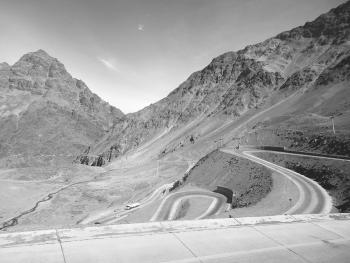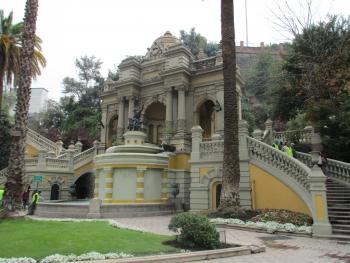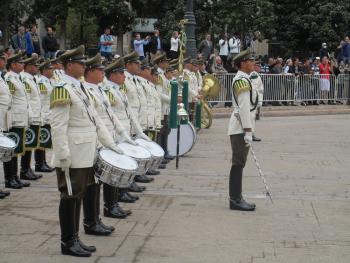A spectacular 3-week stay in Santiago
This article appears on page 44 of the November 2016 issue.
Guidebooks, Internet postings and friends all raved about the spectacular road trip from Mendoza, Argentina, to Santiago, Chile. During our spring 2016 visit, we discovered that they were right!
This 230-mile, all-day journey on the luxury (semi cama) El Rápido Bus took us through some of the world’s most spectacular scenery. From Mendoza’s vineyards of green, we traveled across cactus-laden desert, through countless tunnels and past raging whitewater rapids, snowcapped Mt. Aconcagua (about 23,000 feet) and stark, moon-like terrain and mountains, finally arriving at the Los Libertadores border crossing into Chile.
There, the rigorous Chilean Customs and Border authorities, with guns and dogs, went about their work. We were told these formalities could take up to 14 hours, but we were fortunate that ours only took just over an hour.
Even though the Chilean authorities charge huge fees at the Santiago airport for entry visas (for Americans, $160 each), the land crossing on the bus from Argentina offered free entry into Chile… and a more fascinating, scenic experience.
Once in Chile, we continued down the slopes of the Andes, our driver safely and carefully negotiating the road’s 28 dizzying hairpin turns. Finally, eight hours after leaving Mendoza, we arrived in Chile’s capital, Santiago.
Santiago
It did not take long for us to get back into the “vibe” of Marvin’s favorite city. Having just spent two weeks in Argentina, we found a different atmosphere in Santiago. It appeared to be more relaxed and upbeat than Buenos Aires, likely a reflection of its relative prosperity.
We love to try to fit in like locals, and our Spanish skills helped us in our efforts. (When people asked us in Spanish for directions, we knew we had succeeded).
On both buses and the newly expanded efficient subway system, we used our Bip! public transport card (CLP1,500, or about $2, for the card, which then had to be loaded with a minimum of CLP1,000), which took us to beautiful public parks, handicraft markets and the city center (Centro), with its massive 18th-century cathedral situated on the enormous Plaza de Armas.
Part of Santiago’s charm is its many barrios (neighborhoods), which we explored. In tiny Plaza Concha y Toro, the owner of a restaurant greeted us and took us on an extensive tour of his elegant establishment (a former palace). What a delightful surprise!
Living like a local
After a few days’ stay at Hotel Casa de Lyon (Arzobispo Larraín Gandarillas 140), we moved to a small, well-equipped Airbnb.com apartment in Centro ($35 per night) for our extended stay in the city. This made us feel more like residents than tourists, as we explored our barrio and shopped with locals at supermarkets and curbside fruit stalls. There was nothing like the tantalizing smells of orange juice, squeezed before our eyes, fresh-from-the-oven pastries from countless bakeries and espresso from neighboring cafés!
Cultural offerings were many, and we attended a superb, stirring concert (Richard Strauss/Elgar/Dvor˘ák) performed by the world-class Santiago Philharmonic Orchestra in the old-world Teatro Municipal, just 10 minutes’ walk from our apartment. We were so taken by the excellent acoustics and atmosphere that we returned to buy tickets for a later performance by the Santiago Ballet.
There is also a vibrant Jewish community there, and we were warmly welcomed at the Jewish synagogue, Círculo Israelita de Santiago. This enormous complex was stunning, but more meaningful were the uplifting service and the friendly congregants who invited us to their homes.
More diverse and interesting barrios were to be discovered, each with its own unique flair and personality. In colorful Barrio Yungay, we lunched at the quirky 1868 Peluquería Francesa (French Barbershop), a cluttered mess of antiques within what is still a functioning barbershop. And, in equally colorful Barrio Bellavista, we toured La Chascona, the fascinating, flamboyant Santiago home (now a museum) of poet/diplomat/politician Pablo Neruda, winner of the 1971 Nobel Prize for Literature. It brought back memories of his (very different) home in Valparaíso that we visited years before.
At Santiago’s Central Market we sampled empanadas — Latin America’s favorite fast food — from the city’s number-one-rated empanadería (over 100 years old!) before downing a tasty lunch of fresh corvina (similar to sea bass) in the historic Central Market building.
Seeing the sights
Unfortunately, smog can be a problem in Santiago. Nevertheless, on a somewhat clear day, we went to the top of Cerro San Cristóbal for a panoramic view of this sprawling city. On another day, when we awoke to blue skies, we seized the moment and went to the top (64th floor) of the dazzling new Costanera Tower, Latin America’s tallest building, for even better views.
One “must see” was the Changing of the Guard in Plaza de la Constitución, just behind La Moneda, the Presidential Palace. This 40-minute ceremony featured more than 100 formally dressed soldiers in crisp uniforms as well as bands, flags and officers on horses — an impressive display of Chilean national pride.
What could be more impressive? Lunch, of course… at the 140-year-old Confitería Torres, a time-warp classic with photos of past patrons (including all of Chile’s presidents) together with aging waiters who had given a lifetime of service. What fun it was to be there!
Museums on every topic can also be found in Santiago. Its National History Museum, housed in the 1807 Spanish-colonial Royal Audience building, took us from prehistoric and colonial times to the contemporary republican era, giving us a better understanding of Chile’s sometimes-difficult history.
The fascinating Chilean Pre-Columbian Art Museum, in the Royal Customs House, had artifacts dating back thousands of years to a time before the first Europeans arrived on the continent.
As we entered the stark Museum of Memory and Human Rights, we remembered our Berlin visit to the Holocaust museum, where Germany faced its bleak Nazi history. The huge modern complex in Santiago detailed the brutal military junta that governed Chile from 1973 to 1990, during which time some 40,000 political opponents were tortured, executed or “disappeared.”
On a brighter note, we joined happy crowds in the trendy suburb of Providencia, where, surprisingly, we came across an ASEAN (Association of Southeast Asian Nations) culture-and-food festival. The Indonesians and Malaysians there were equally surprised when Carole started chatting with them in their language!
Vino and vibes
For years we have bought Concha y Toro wine at home, finding it to be both delicious and of great value (often less than $10 a bottle). We find their reds to be the most enjoyable. So how could we resist a tour of their winery, located in the scenic Maipo Valley, less than two hours from Santiago?
On a blue-skied day, extraordinary for this often cloudy city, we passed up an expensive door-to-door winery tour available from our hotel and instead took public transport (for pocket change) to the gate of the largest winery in the continent and reportedly the fourth-largest wine producer in the world. The trip in itself was a great adventure!
At the winery, our English-speaking guide was a young lady with a keen sense of wit. Not only was the entire facility spectacular, the original family house and gardens lovely and the wine tasting delightful, the lunch there was one of the best we experienced on this trip. If the purpose of this tour was to win more customers, they sold us, especially since we now know about the many varieties they offer. We booked this tour online and paid ($18 per person) on arrival.
Living in Santiago for three weeks allowed us to do more than just the things suggested in guidebooks. Indeed, our little apartment felt like home, and we sank our roots into the barrio, getting to know the strawberry vendor on the corner, the barista at the local café, who knew which coffees we preferred, and the staff at the bakery where we regularly purchased empanadas. Everyone recognized and greeted us, exchanging jokes with us in Spanish.
Downtown, we ate delicious Chilean comfort food for next to nothing. And within a block of our apartment was the Grand Lodge of Chile, where Marvin was warmly welcomed and given a tour as a fellow Master Mason.
Beyond the basics
Our desire to go outside the box took us to areas not usually visited by travelers. In Barrio Recoleta, we headed into the frenzy of La Vega Central Market, where Chile’s extraordinary variety of superb fruits and vegetables are sold. The vendors soon became our “professors,” as they taught us the Spanish words for apricots, eggplant, passion fruit, etc.
This barrio is also home to a sizable Asian and Middle Eastern community, adding to the global feel of the capital city.
One night, in a small church, we attended a free concert of “sacred music,” with orchestra, organist, choir and soloists from the nearby Catholic university — a wonderful experience. Afterward, we joined local diners for a 10 p.m. meal in a nearby Peruvian restaurant. (Peruvian food was wildly popular in Chile.)
The richest part of Santiago is, no doubt, her warm, cultured and welcoming people. Fortunately, we were invited for dinner at the home of some new friends. The table was full of interesting stories, lively conversation, good humor and warmth. Before we knew it, the clock struck 2 a.m. Such is the Latin way of life!
It was our great fortune to attend the final date of “Mayerling” performed by the Santiago Ballet (music by Liszt). The gorgeous setting of the elegant Teatro Municipal plus the dazzling costumes and physically demanding choreography made for a gala event. This was also the farewell performance for the ballet’s principal male dancer, and the tumultuous ovation by adoring fans who showered him with flowers was amazing.
Following two cold days of incessant rain, we awoke to bright-blue, sunny skies. It was Marvin’s birthday!
We celebrated in fine style with lunch at a lovely neighborhood restaurant, where Marvin downed a birthday pisco sour. Santiago was right where he wanted to celebrate the big “Seven-Ohh!”
Reflections
After a marathon all-day journey from Santiago to our home in Jacksonville, we reflected on our wonderful trip.
This trip to Argentina and Chile fulfilled our aims and dreams: to explore beyond Buenos Aires and to spend an extended period of time in Santiago.
Our Spanish-language skills (though not fluent) helped, as English was not widely spoken. Argentinean Spanish was difficult for us to understand, while Chilean Spanish was far easier. Our study of the language had paid off!
In the places we visited in both countries, the food and lifestyle were very European. Spanish and Italian dishes and customs predominated. We slowed our pace to fit into the local rhythm, with most restaurants taking almost an hour to bring food, even a simple salad. Meals in both countries were leisurely, tasty and very reasonably priced, ranging from $6 per person for an “executive lunch” to $20, including wine, for a high-end splurge.
Our accommodations were very comfortable and also reasonably priced. Our little Santiago apartment, perfect for our 3-week stay there, felt like home.
A few challenges faced us on this trip. Argentina’s financial problems made ATM, credit card and public transport transactions difficult though not insurmountable. In Santiago, Marvin was pickpocketed on a crowded subway, which was distressing, but our US banks quickly resolved things and prevented any financial harm to us.
The best? The people! Displaying Latin warmth and kindness, they could not have been nicer.



